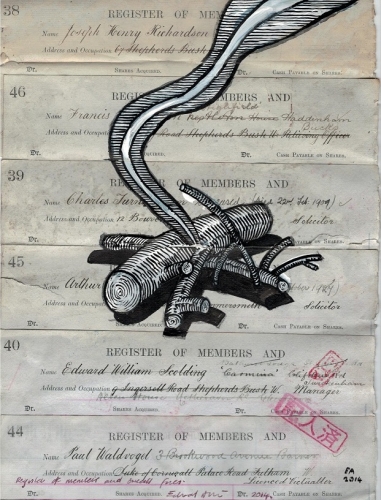Ral Veroni
Because paper is the default surface for an artist to draw on we can forget how charged with meaning certain papers can be. In Ral Veroni's drawings on paper money, “Lucha Por La Vida or Struggle For Life”, he responded on the devaluing of bank notes during periods of hyper inflation in Argentina, a time when the country was in a recession and money was practically worthless. Initially drawing on banknotes in ink and brush, he then made the drawings into screen prints, the bank notes once printed on being worth more than their face value. He was in effect, arguing that money is only paper with an agreement, a drawing on one particular piece of paper being a particular type of agreement about ideas exchange and the image of the queen printed on another piece of paper in another country being part of another type of agreement about the promise to pay the bearer of this image a certain amount of hard cash.
A skeletal “day of the dead” head stares out of the cover of his small artist's book, which consisted of a collection of his printed bank notes, with a written explanation.
Ral Veroni
Hanna von Goeler has also used money as a surface on which to make comments about the world, in her case this is something not driven by dire necessity but by an interest in the aesthetic potential of banknotes and how this is suffused with political possibility.
Hanna von Goeler
Sometimes whiting out to reveal underlying elements in the design and at others applying a lot more attention to various elements by reversing and/or copying and adding text; von Goeler reveals how much of an impact these things have on the visual narratives of our lives. As a child I remember being fascinated by the complexity of the designs of banknotes, their intricate patterns could suck me into them until I become totally lost in their contemplation.
As images they are very powerful, this one below for a trillion dollars could be made to stand for the consequences of misrule.
Bank of Zimbabwe: Trillion dollar note
The present conservative government is seen as carrying on the heritage of Margaret Thatcher in this series if prints by 'Wefail'.
Wefail
In Leeds I have been involved with the development of the Leeds Creative Timebank. This is another response to the issues surrounding money and how it has become so central to our understanding of our relationships with each other and the world as a whole. There have of course been similar initiatives elsewhere and they have nearly always resulted in the design of an alternative currency, in Carolina Caycado's case she defaces existing notes.
Carolina Caycado: cash for an artrists' timebank
Bank notes were not always the main form of exchange. And Hew Locke reminds us of the important role of share certificates in the development of the capitalist economies and their role in supporting the development of slavery as a capitalist economic venture.
Hew Locke: Share Certificate
We are moving towards a time when all money transactions will be paperless, money will be virtual and banknotes will become things of the past, just like written out book ledgers, their formats will remind us of ways of doing things that no longer exist. The artist Edward Allington used those old ledgers and other outdated legal documents; which can be thought of as conceptually and aesthetically related to outdated bank notes, on which to make his drawings.
Edward Allington
Allington would white out the area he was going to draw on and then use a style of drawing heavily influenced by engravings, 1950s illustrational drawing styles and 17th century technical drawings, to visualise ideas for sculpture.
Detail of an engraving
17th century technical drawing
1950s illustration
After the 1950s printing techniques became much more sophisticated and the need for black and white drawn illustrations was gone, Allington's drawings brought together various forms of visual redundancy and in doing so created something new that was a result of the dialogue set up between the different visual languages of paper surface and the mark making involved in creating the image. Ledgers would once have been vital to the regular ordering of society, recording the transfer of funds and ensuring that no one could cheat or forfeit on a payment. However in time the hand written records of these transfers become worthless and like Veroni, Allington gave new value to what had lost its use. Creative capital, replacing economic capital or former use value.
What worth are these?
I have in the past put up several blog posts on different ways to think about paper, the key issue being that the surface on which you make your images has potentially as much to say as the images you put upon it.
See also:
The languages of paper and cardboard
Research into paper
Interesting on-line books on paper
Drawing in or with paper
More thoughts about paper
Paper folding and the songs of trees
The related videos below illustrate a performative aspect to working with paper, you could say that the elephant in the room is not the elephant at all, it is how any collaborative venture can become an artwork if it is seen as a relational practice.
The languages of paper and cardboard
Research into paper
Interesting on-line books on paper
Drawing in or with paper
More thoughts about paper
Paper folding and the songs of trees





















No comments:
Post a Comment